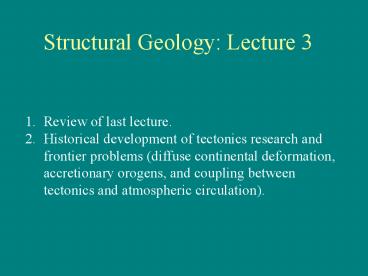Structural Geology: Lecture 3 - PowerPoint PPT Presentation
1 / 21
Title: Structural Geology: Lecture 3
1
Structural Geology Lecture 3
- Review of last lecture.
- Historical development of tectonics research and
frontier problems (diffuse continental
deformation, accretionary orogens, and coupling
between tectonics and atmospheric circulation).
2
Summary of Last Lecture
- Historical development of Structural Geology.
- Relationship between structural geology and
tectonics.
3
- Historical Perspective for Research in Tectonics
- 1960s, invention of plate tectonics (Dark age
before that). - 1970s testing predictions of plate tectonics
(locating paleo-sutures, magmatic arcs, various
types of basins and metamorphic belts related to
plate tectonics). - Since the early 1980s, geologists found two
important departures from the simple
plate-tectonics theory - (a) Diffuse continental deformation (rigid
microplate kinematics vs. boundary-value
continuum-mechanics problems such as Tibet and
western US) - (b) Accreted orogenic belts with multiple
sutures, arcs, and oceanic-basin deposits such
as in the northern part of the North American
Cordillera and central Asia (far-traveled vs.
in-board accretion) How continents have grown? - 4. Since mid-199s, Earth-system approach deals
with lithospheric deformation coupled with
atmospheric circulation.
4
- Current tectonics research Three frontiers
- Mechanics and dynamics of continental tectonics.
- Mechanisms of accretionary orogenesis and its
role in continental growth. - Couling and feedback processes between
lithosphheric deformation and atmospheric
circulation
5
The essence of plate tectonics large rigid
plates moving on Earths surface and interact
with one another
6
Plate tectonics rigid plates moving in the outer
layer of the Earth
This works best for the oceanic plates, but not
in the continents!
7
However, diffuse deformation is common in
continental regions, defying the simple
predictions of plate tectonics
8
Seismicity in Tibet and central Asia
9
Diffuse Continental Deformation Asia and North
American
Basin and Range
Indo-Arabian-Eurasian collision zone
10
Models for Continental Deformation
Predicts high number of faults distributed
throughout Tibet
Fault move at relatively slow rates ( mms/yr)
11
Another complication of plate tectonics
Accretionary orogens with multiple arcs, multiple
sutures, mutiple micro-continent blocks and
multiple ocean basins.
12
Accreted area in NAC
Accreted area in CAOS
CAOS Central Asia Orogenic System NAC North
American Cordillera
The CAOS is three times larger than the accreted
portion of the North American Cordillera, thus
presenting the largest accreted continental
materials in the Phanerozoic.
13
North America Accretionary orogen
CAOS
Central Asia Orogenic System
CAOS
CAOS is the largest Phanerozoic accretionary
orogen in the world
14
Strike-slip duplex developed during oceanic
subduction
A
A
1000 km
1000 km
Duplication of a single arc by strike-slip
faulting
1000 km
A
A
A
A
1000 km
A
A
Sengor and Natalin, 1996
1000 km
15
Reconstruction of CAOS across Chinese-Mongol
Altai (collision of multiple arcs)
16
Coupling between lithospheric deformation and
atmospheric circulation An emerging area of
research
Heavy erosion induces lower crustal flow to
generate mountains
17
The best expression of feedback processes between
atmospheric circulation and lithospheric
deformation is the evolution of landscapes. This
has led to many exciting questions such as how
long it takes for a mountain range to reach a
steady state (i.e., no change in topography) and
how climate controls the strain distribution over
a mountain range.
18
Flux steady state erosional flux accretionary
flux
19
Channel flow extrusion/rapid denudation model
Beaumont et al. (2001) developed a model with a
coupled brittle- ductile crustal rheology,
including a stepped viscosity decrease at 700oC.
By building a high plateau and permitting focused
erosion, channel flow results in extrusion of
middle crust at surface.
Beaumont et al. (2001)
20
(No Transcript)
21
- Summary of tectonics research Three frontiers
- Mechanics and dynamics of continental tectonics.
- Mechanisms of accretionary orogenesis and its
role in continental growth. - Feedback processes between lithosphheric
deformation and atmospheric circulation































